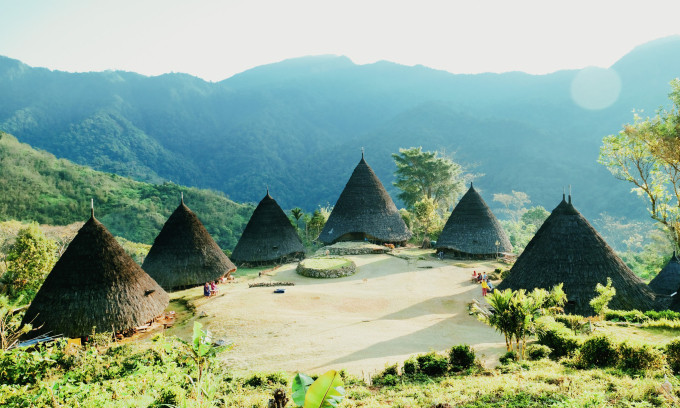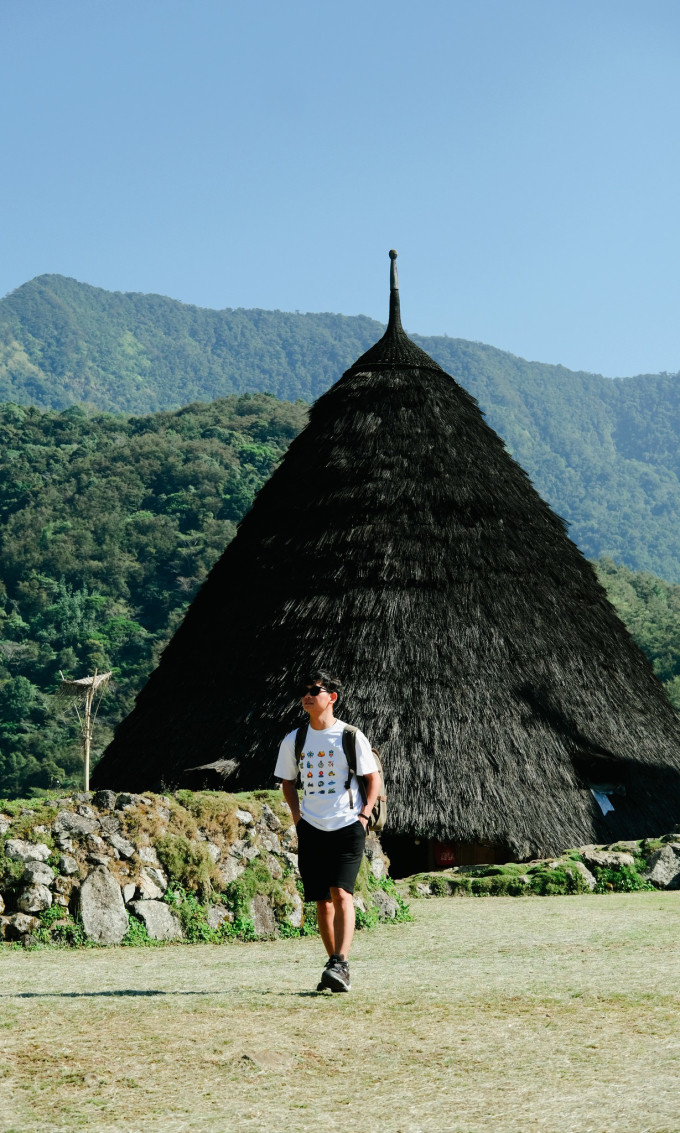Tai spent a night in the 100-year-old village of Wae Rebo, the only place with traditional Indonesian pyramidal houses left.
The traditional village of Wae Rebo in Manggarai district on Flores island, east of Nusatenggara, received the UNESCO Top Excellence Award in the 2012 UNESCO Asia Pacific Heritage Awards. The village recreates traditional Mbaru Niang houses and is currently the only village in Indonesia that still maintains this architecture.

Wae Rebo Village is the only place in Indonesia where traditional pyramid-shaped houses still exist.
According to the Indonesian Ministry of Tourism website, the village was built by a man named Empu Maro more than 100 years ago. Today, the residents are his descendants.
Arriving at the village on September 13, travel blogger Tai Pham (28 years old, Ho Chi Minh City) was impressed by the "difference, uniqueness and tranquility of the village". Although he had seen the pictures sent by an Indonesian friend, he was still surprised to witness and experience life here for two days.
A small village located at an altitude of about 1,100 m above sea level, Wae Rebo is surrounded by mountains and dense Todo forest, completely isolated from outside life. The village has no phone signal or wifi and electricity is only available from 6pm to 10pm. In return, Tai can enjoy the fresh air, listen to the birds singing in the forest and immerse himself in the slow, simple life of the local people.
The first thing tourists like Tai have to do is to pay their respects to the village elder so that he can perform a welcoming ceremony and receive his blessings. After that, he can enjoy a cup of coffee made from coffee beans grown around the village. After the ceremony, he is free to go sightseeing, take pictures, and take photos.
Tai was welcomed into the main and largest house in the village. This was the communal house where villagers gathered to perform rituals and festivals. Inside the house were kept family heirlooms such as gongs and drums. Most of the villagers were Catholic but still followed their old beliefs.

Tai walked around the village after greeting the village elders and performing the welcoming ceremony.
The houses in Wae Rebo are called Mbaru Niang, conical in shape, with high peaks and covered with lontar leaves, a palm tree that grows widely in Indonesia. The houses have five floors, each designed for a specific purpose. The first floor, called the lutur or hut, is where the extended family lives. The second floor, called the lobo, or attic, is used to store food and goods. The third floor is the lentar, which is used to store seeds for the next harvest. The fourth floor is the lempa rae, which is used to store food in case of drought. The fifth floor is the hekang kode, which is considered the most sacred place, used to worship ancestors.
Looking at the whole view, the pyramidal houses are arranged in a V shape, with the space in the middle being a common yard for people to live in. "At dawn, the sun slowly rises behind the cliff and shines its first rays, covering the village in a golden color," Tai described as "the most beautiful moment" here.
Locals say that there used to be more than 1,000 people living in the village, but now there are only about 100. Young people have gone down the mountain to make a living, leaving the village mostly with only children and the elderly.
There are 8 households living in the communal house, each in a room. "Like other areas, the people are friendly, welcoming and warm towards tourists," Tai commented.
The villagers grow coffee, vanilla, cinnamon, and some fruits and sell them at the market about 15 km away. About 20 years ago, the local government supported the development of Wae Rebo village as a tourist destination and tourism is now the main source of income for the villagers.
Because it is isolated and surrounded by mountains and forests, Wae Rebo has a colder climate than outside, so visitors should bring warm clothes because the temperature drops sharply at night. The locals mostly eat rice and eggs, so visitors should prepare some snacks such as chocolate, cakes, and candies to eat on the road or in case they don't like the food, Tai shared. He especially noted that near the village elder's house there is a rock that has sacred significance to the villagers, and visitors should absolutely not climb or sit on it.
To reach the village, Tai traveled from Bali to LaBuan Bajo airport. From here, visitors can go by motorbike or car, but it is recommended to travel by motorbike for convenience, which takes about 15 - 20 minutes. After the motorbike road ends, Tai continued trekking for about 2 - 2.5 hours to reach the village. "The mountain climbing is not too difficult, just prepare suitable clothes and wear shoes with good grip," Tai said.
Because of the village’s isolation, visitors must stay overnight. This is a factor that limits the number of tourists, however, “the sunrise at Wae Rebo will not disappoint,” Tai said. Tai’s trip cost about 2,700,000 VND, including transportation from Labuan Bajo to Wae Rebo village, meals and accommodation throughout the journey. If you go on your own, the entrance fee, overnight accommodation, and a dinner and breakfast would cost 300 IDR (about 470,000 VND).
Visitors should visit Wae Rebo village during the dry season, around April - October to enjoy the lush green landscape of the Manggarai highlands and avoid the heavy thunderstorms that often occur in the mountainous areas around the end of the year.
At Wae Rebo, during the day, visitors can explore the valley and interact with the villagers. At night, "the starry sky makes the scene here more sparkling and magical," Tai said.
According to VnExpress